Home / Antiperiplanar Relationships: The E2 Reaction and Cyclohexane Rings
Elimination Reactions
Antiperiplanar Relationships: The E2 Reaction and Cyclohexane Rings
Last updated: January 21st, 2025 |
Antiperiplanar Relationships Between C-H And The Leaving Group: The E2 Reaction and Cyclohexane Rings
Here we come to a very testable application of the E2 reaction – how to draw the products of E2 reactions in cyclohexane rings!
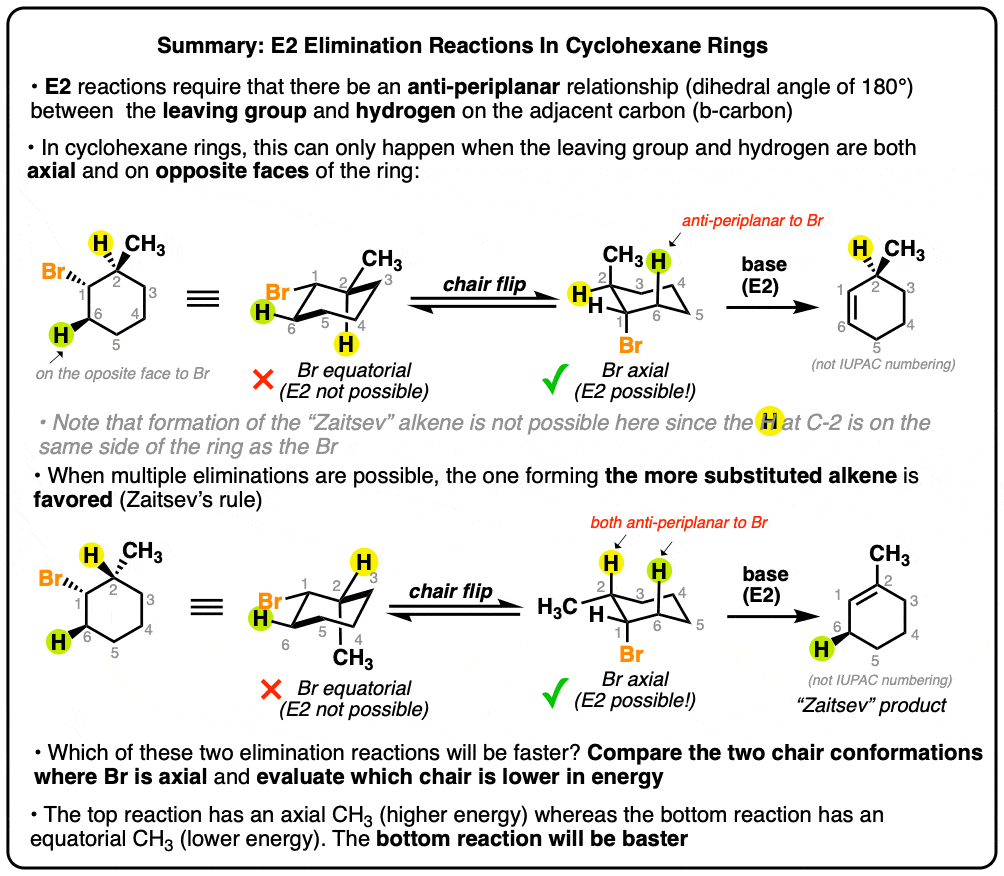
Table of Contents
- In The E2 Reaction, The Leaving Group Is Always “Anti-Periplanar” To The Hydrogen That Is Removed On The Adjacent Carbon (“Beta-Carbon”)
- In Cyclohexane Rings, E2 Reactions Can Only Occur When The Leaving Group Is Axial
- In E2 Reactions Of Cyclohexane Rings, The Only Way The Leaving Group And C-H Bond Can Be Anti-Periplanar Is If They Are On Opposite Faces Of The Ring
- Some Examples: What Would Be The Major E2 Product In Each Case?
- Cyclohexane Substituents Can Affect The Rate Of E2 Elimination Reactions In Cyclohexane Rings
- The Higher The Concentration Of The Conformer With An Axial Leaving Group, The Faster The Elimination Will Be
- Notes
- (Advanced) References and Further Reading
1. In The E2 Reaction, The Leaving Group Is Always “Anti-Periplanar” To The Hydrogen That Is Removed On The Adjacent Carbon (i.e. the “Beta-Carbon”)
Last time we compared the E1 and E2 reactions and mentioned one of the key differences was the stereochemistry of the E2 reaction. Remember that in the E2, the leaving group is always “anti” to the hydrogen that is removed on the adjacent carbon. [That means that they’re directly opposed to each other, or 180°; kind of like the minute hand and the hour hand when a clock reads 6:00].
This is an extremely important detail to be able to apply in reactions.
2. In Cyclohexane Rings, E2 Reactions Only Occur When The Leaving Group Is Axial
One way this often comes up is in discussions of cyclohexane rings. If you’ll recall, in the cyclohexane chair conformation, groups can either be axial (pointing straight up or down) or equatorial (pointing “somewhat up” or “somewhat down”).
In order for a hydrogen to be “anti” to a leaving group, it’s required that both groups be axial. Look closely at the cyclohexane ring on the left, where the leaving group is equatorial – see how the group that is “anti” is the C-C bond [highlighed in red]?
That E2 is never gonna work!
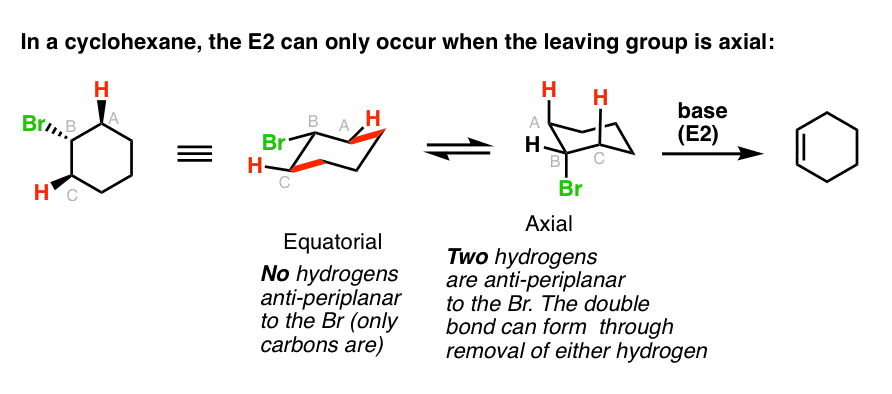
So if you draw the leaving group equatorial in a cyclohexane chair, you’ll have to do a chair flip so that the leaving group is axial. That’s shown in the right hand example, where an E2 can actually happen.
3. In E2 Reactions Of Cyclohexane Rings, The Only Way The Leaving Group And C-H Bond Can Be Anti-Periplanar Is If They Are On Opposite Faces Of The Ring
This brings us to the second point. If the leaving group is, let’s say, on the “top” face of the cyclohexane, you can only form an alkene to adjacent carbons where the hydrogen is on the opposite face.
You might remember the example from last time where we couldn’t form the “Zaitsev” alkene because the Br was a wedge and there was an alkyl group on the carbon next door that was on the opposite face. In this case we can only form the less substituted alkene. If the methyl group is switched, however, then the E2 to give the Zaitsev product becomes possible:
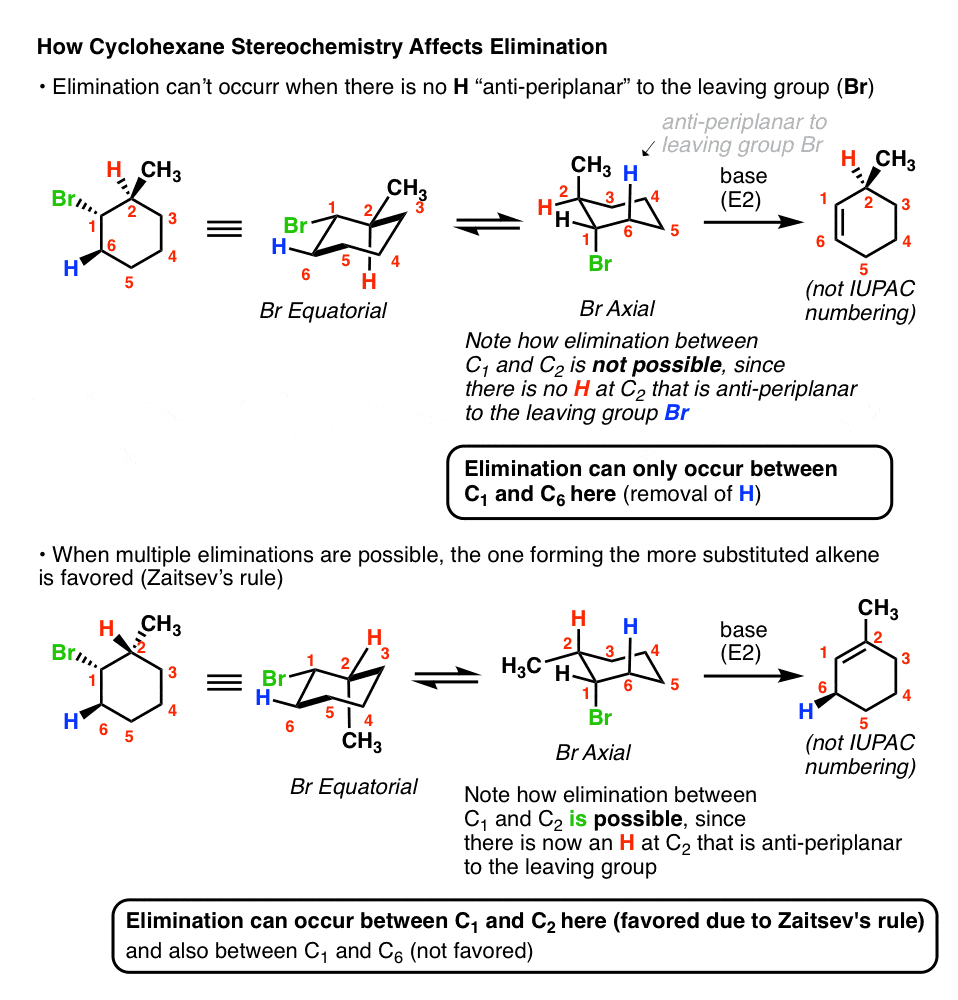
The bottom line here [and trust me, this comes up in tests, a lot!] is that you always want to pay attention to what side of the ring your leaving group is on, and make sure that the E2 you draw is indeed possible.
4. Some Examples: What Would Be The Major E2 Product In Each Case?
Here are some more examples to think about. What would be the major E2 product in each case?
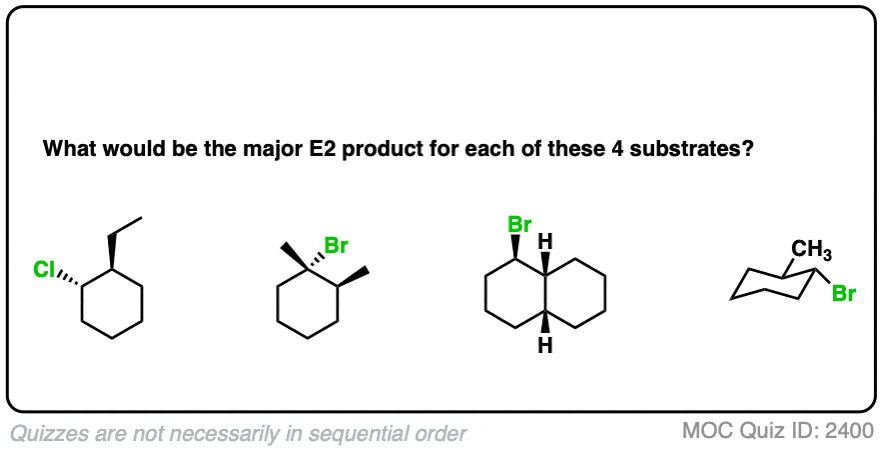 Click to Flip
Click to Flip
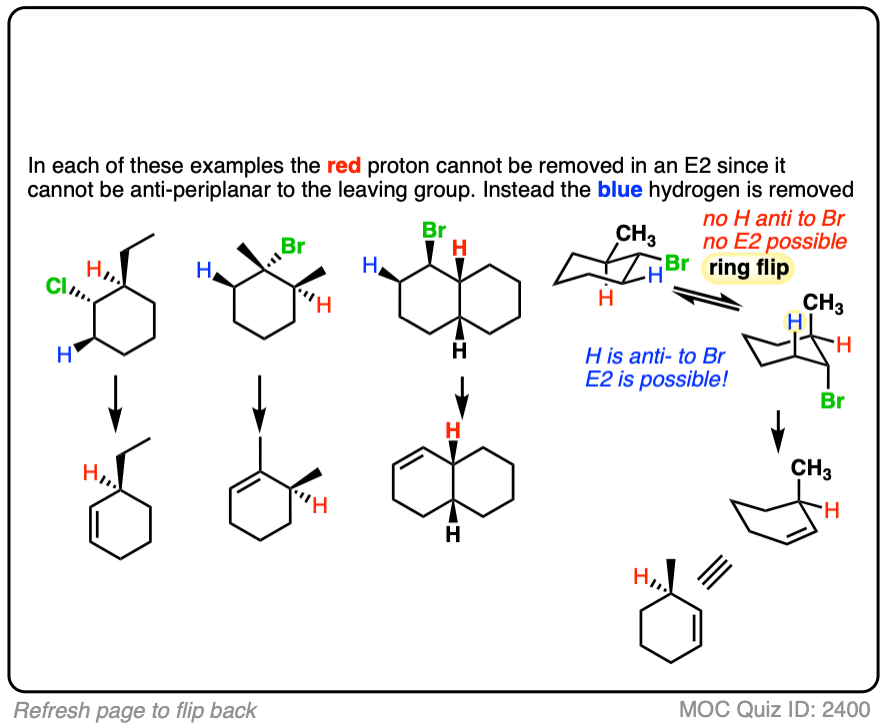
Now, let’s talk about a very interesting application of what we just discussed. This is a little more advanced, but see if you can follow it through. It ties together what we’ve discussed about the E2 with what you’ve previously learned about cyclohexane chair flips.
5. Cyclohexane Substituents Can Affect The Rate Of E2 Elimination Reactions In Cyclohexane Rings
Imagine you’ve got two alkyl halides, and they’ve got slightly different structures. We make the following observation: E2 with the second starting material is significantly faster than E2 with the first product. Question: why might this be?
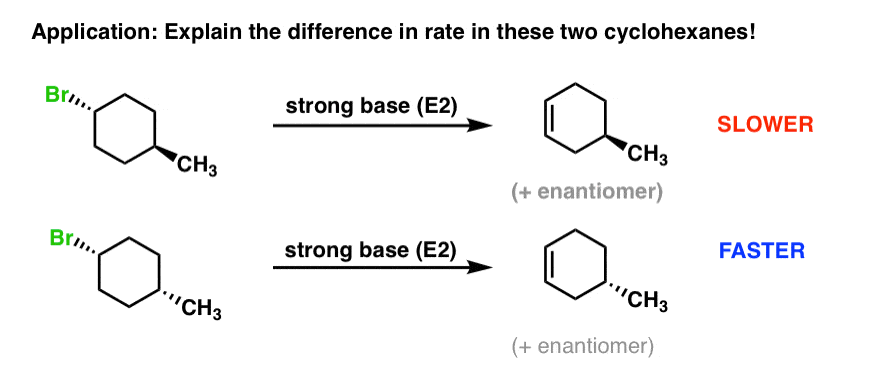
In order to understand what’s going on, it would help to draw the cyclohexane chair forms of both of these molecules. So let’s do that and then have a closer look.
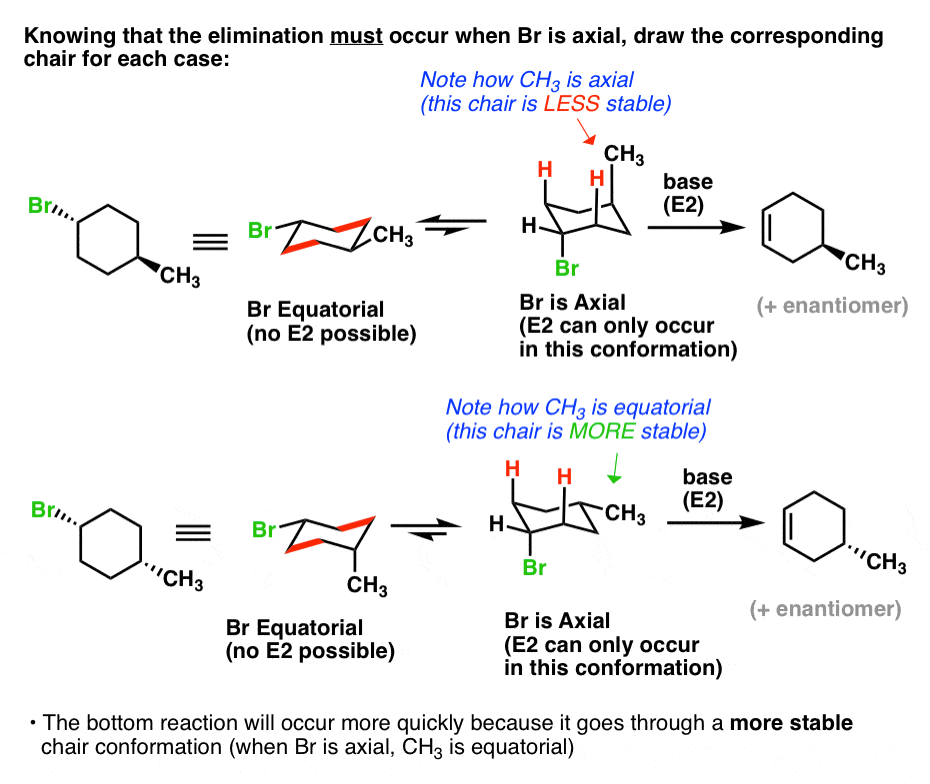
What’s going on? Each molecule will have an equilibrium between two chair forms.
In the top molecule, the left-hand conformation is favored, because the bulky methyl group [CH3 is actually bulkier than Br] is equatorial. So equilibrium will favor the left hand molecule.
In the bottom molecule, the rightmost conformation is favored, because the bulky methyl group is equatorial. So equilibrium will favor the right-hand molecule.
6. The Higher The Concentration Of The Conformer With An Axial Leaving Group, The Faster The Elimination Will Be
Notice something interesting? Remember that in order for E2 to occur, the leaving group must be axial.
So there’s only one conformation where this will be possible for each ring. However, in the top example, Br is axial only in the least stable conformation, whereas in the bottom example, Br is axial in the most stable conformation. Since the bottom example will have a higher concentration where Br is axial, it will be faster.
Isn’t it interesting how it all ties together? Concepts you learn in one chapter can come back and be applied in later chapters!
In the next post we’ll talk about another example where Zaitsev’s rule doesn’t apply.
Next Post: Bulky Bases in Elimination Reactions
Notes
Related Articles
(Advanced) References and Further Reading
- Abspaltungsreaktionen und ihr sterischer Verlauf
Walter Hückel, Werner Tappe, Günter Legutke
Lieb. Ann. Chem. 1940, 543 (1), 191-230
DOI: 10.1002/jlac.19405430117
An early study of E2 stereochemistry on menthyl derivatives. - Mechanism of elimination reactions. Part XVIII. Kinetics and steric course of elimination from isomeric benzene hexachlorides
E. D. Hughes, C. K. Ingold, and R. Pasternak
J. Chem. Soc. 1953, 3832-3839
DOI: 10.1039/JR9530003832
The name of this paper is a little confusing since ‘benzene hexachloride’ does not refer to hexachlorobenzene, but 1,2,3,4,5,6–hexachlorocyclohexane. Hexachlorocyclohexane has a few isomers depending on the orientation of the Cl atoms, as explained in the paper. Depending on the orientation of the Cl atoms in the isomer, different products are obtained, based on whether an E2 pathway is possible at those position(s). - Mechanisms of Elimination Reactions. X. Deuterium Exchange in Base-Promoted Dehydrochlorination of β-Benzene Hexachloride
Stanley J. Cristol and Delbert D. Fix
Journal of the American Chemical Society 1953, 75 (11), 2647-2648
DOI: 1021/ja01107a027
Classic study of hexachlorocyclohexane isomers – all chlorine atoms on adjacent carbon atoms are trans to each other, so it is impossible to bring adjacent hydrogen and chlorine into an anti relationship without causing ring strain. - Mechanism of elimination reactions. Part XIX. Kinetics and steric course of elimination from isomeric menthyl chlorides
E. D. Hughes, C. K. Ingold, and J. B. Rose
J. Chem. Soc. 1953, 3839-3845
DOI: 10.1039/JR9530003839
This paper illustrates Zaitsev’s rule in a cyclohexane system. Neomenthyl chloride gives 78% 3-menthene and 22% 2-menthene with EtO– in ethanol . - Mechanism of elimination reactions. Part XXII. Anomalous elimination from the trimethylneomenthylammonium ion
E. D. Hughes and J. Wilby
J. Chem. Soc. 1960, 4094-4101
DOI: 10.1039/JR9600004094
This paper perfectly illustrated the concepts explained in this section. Menthylammonium ion cannot undergo elimination to give the 3-olefin, since the anti position on C4 is occupied by the isopropyl group. Only the 2-olefin is obtained from elimination with menthyl-LG (LG = leaving group, chloride, trimethylamine, etc.). In neomenthyl-LG, the isopropyl group is not anti, and so the 3-olefin is accessible. However, the yield of the 3-olefin decreases from 88% to 65% when EtO– is used instead of OH–, and it would be likely to decrease further when using bulkier bases (e.g. tBuO–). - Neighboring Carbon and Hydrogen. XIX. t-Butylcyclohexyl Derivatives. Quantitative Conformational Analysis
S. Winstein and N. J. Holness
Journal of the American Chemical Society 1955, 77 (21), 5562-5578
DOI: 10.1021/ja01626a037
This is the classic paper by Prof. Winstein introducing the concept of A-values. There is a brief mention of the effect of axial/equatorial orientation of the leaving group on reactivity. When the leaving group is axial, an E2 pathway is favored, but when the leaving group is equatorial, a mix of E1 and SN1 takes place.
00 General Chemistry Review
01 Bonding, Structure, and Resonance
- How Do We Know Methane (CH4) Is Tetrahedral?
- Hybrid Orbitals and Hybridization
- How To Determine Hybridization: A Shortcut
- Orbital Hybridization And Bond Strengths
- Sigma bonds come in six varieties: Pi bonds come in one
- A Key Skill: How to Calculate Formal Charge
- The Four Intermolecular Forces and How They Affect Boiling Points
- 3 Trends That Affect Boiling Points
- How To Use Electronegativity To Determine Electron Density (and why NOT to trust formal charge)
- Introduction to Resonance
- How To Use Curved Arrows To Interchange Resonance Forms
- Evaluating Resonance Forms (1) - The Rule of Least Charges
- How To Find The Best Resonance Structure By Applying Electronegativity
- Evaluating Resonance Structures With Negative Charges
- Evaluating Resonance Structures With Positive Charge
- Exploring Resonance: Pi-Donation
- Exploring Resonance: Pi-acceptors
- In Summary: Evaluating Resonance Structures
- Drawing Resonance Structures: 3 Common Mistakes To Avoid
- How to apply electronegativity and resonance to understand reactivity
- Bond Hybridization Practice
- Structure and Bonding Practice Quizzes
- Resonance Structures Practice
02 Acid Base Reactions
- Introduction to Acid-Base Reactions
- Acid Base Reactions In Organic Chemistry
- The Stronger The Acid, The Weaker The Conjugate Base
- Walkthrough of Acid-Base Reactions (3) - Acidity Trends
- Five Key Factors That Influence Acidity
- Acid-Base Reactions: Introducing Ka and pKa
- How to Use a pKa Table
- The pKa Table Is Your Friend
- A Handy Rule of Thumb for Acid-Base Reactions
- Acid Base Reactions Are Fast
- pKa Values Span 60 Orders Of Magnitude
- How Protonation and Deprotonation Affect Reactivity
- Acid Base Practice Problems
03 Alkanes and Nomenclature
- Meet the (Most Important) Functional Groups
- Condensed Formulas: Deciphering What the Brackets Mean
- Hidden Hydrogens, Hidden Lone Pairs, Hidden Counterions
- Don't Be Futyl, Learn The Butyls
- Primary, Secondary, Tertiary, Quaternary In Organic Chemistry
- Branching, and Its Affect On Melting and Boiling Points
- The Many, Many Ways of Drawing Butane
- Wedge And Dash Convention For Tetrahedral Carbon
- Common Mistakes in Organic Chemistry: Pentavalent Carbon
- Table of Functional Group Priorities for Nomenclature
- Summary Sheet - Alkane Nomenclature
- Organic Chemistry IUPAC Nomenclature Demystified With A Simple Puzzle Piece Approach
- Boiling Point Quizzes
- Organic Chemistry Nomenclature Quizzes
04 Conformations and Cycloalkanes
- Staggered vs Eclipsed Conformations of Ethane
- Conformational Isomers of Propane
- Newman Projection of Butane (and Gauche Conformation)
- Introduction to Cycloalkanes
- Geometric Isomers In Small Rings: Cis And Trans Cycloalkanes
- Calculation of Ring Strain In Cycloalkanes
- Cycloalkanes - Ring Strain In Cyclopropane And Cyclobutane
- Cyclohexane Conformations
- Cyclohexane Chair Conformation: An Aerial Tour
- How To Draw The Cyclohexane Chair Conformation
- The Cyclohexane Chair Flip
- The Cyclohexane Chair Flip - Energy Diagram
- Substituted Cyclohexanes - Axial vs Equatorial
- Ranking The Bulkiness Of Substituents On Cyclohexanes: "A-Values"
- Cyclohexane Chair Conformation Stability: Which One Is Lower Energy?
- Fused Rings - Cis-Decalin and Trans-Decalin
- Naming Bicyclic Compounds - Fused, Bridged, and Spiro
- Bredt's Rule (And Summary of Cycloalkanes)
- Newman Projection Practice
- Cycloalkanes Practice Problems
05 A Primer On Organic Reactions
- The Most Important Question To Ask When Learning a New Reaction
- Curved Arrows (for reactions)
- Nucleophiles and Electrophiles
- The Three Classes of Nucleophiles
- Nucleophilicity vs. Basicity
- What Makes A Good Nucleophile?
- What Makes A Good Leaving Group?
- 3 Factors That Stabilize Carbocations
- Equilibrium and Energy Relationships
- 7 Factors that stabilize negative charge in organic chemistry
- 7 Factors That Stabilize Positive Charge in Organic Chemistry
- What's a Transition State?
- Hammond's Postulate
- Learning Organic Chemistry Reactions: A Checklist (PDF)
- Introduction to Oxidative Cleavage Reactions
06 Free Radical Reactions
- Bond Dissociation Energies = Homolytic Cleavage
- Free Radical Reactions
- 3 Factors That Stabilize Free Radicals
- What Factors Destabilize Free Radicals?
- Bond Strengths And Radical Stability
- Free Radical Initiation: Why Is "Light" Or "Heat" Required?
- Initiation, Propagation, Termination
- Monochlorination Products Of Propane, Pentane, And Other Alkanes
- Selectivity In Free Radical Reactions
- Selectivity in Free Radical Reactions: Bromination vs. Chlorination
- Halogenation At Tiffany's
- Allylic Bromination
- Bonus Topic: Allylic Rearrangements
- In Summary: Free Radicals
- Synthesis (2) - Reactions of Alkanes
- Free Radicals Practice Quizzes
07 Stereochemistry and Chirality
- Types of Isomers: Constitutional Isomers, Stereoisomers, Enantiomers, and Diastereomers
- How To Draw The Enantiomer Of A Chiral Molecule
- How To Draw A Bond Rotation
- Introduction to Assigning (R) and (S): The Cahn-Ingold-Prelog Rules
- Assigning Cahn-Ingold-Prelog (CIP) Priorities (2) - The Method of Dots
- Enantiomers vs Diastereomers vs The Same? Two Methods For Solving Problems
- Assigning R/S To Newman Projections (And Converting Newman To Line Diagrams)
- How To Determine R and S Configurations On A Fischer Projection
- The Meso Trap
- Optical Rotation, Optical Activity, and Specific Rotation
- Optical Purity and Enantiomeric Excess
- What's a Racemic Mixture?
- Chiral Allenes And Chiral Axes
- Stereochemistry Practice Problems and Quizzes
08 Substitution Reactions
- Nucleophilic Substitution Reactions - Introduction
- Two Types of Nucleophilic Substitution Reactions
- The SN2 Mechanism
- Why the SN2 Reaction Is Powerful
- The SN1 Mechanism
- The Conjugate Acid Is A Better Leaving Group
- Comparing the SN1 and SN2 Reactions
- Polar Protic? Polar Aprotic? Nonpolar? All About Solvents
- Steric Hindrance is Like a Fat Goalie
- Common Blind Spot: Intramolecular Reactions
- Substitution Practice - SN1
- Substitution Practice - SN2
09 Elimination Reactions
- Elimination Reactions (1): Introduction And The Key Pattern
- Elimination Reactions (2): The Zaitsev Rule
- Elimination Reactions Are Favored By Heat
- Two Elimination Reaction Patterns
- The E1 Reaction
- The E2 Mechanism
- E1 vs E2: Comparing the E1 and E2 Reactions
- Antiperiplanar Relationships: The E2 Reaction and Cyclohexane Rings
- Bulky Bases in Elimination Reactions
- Comparing the E1 vs SN1 Reactions
- Elimination (E1) Reactions With Rearrangements
- E1cB - Elimination (Unimolecular) Conjugate Base
- Elimination (E1) Practice Problems And Solutions
- Elimination (E2) Practice Problems and Solutions
10 Rearrangements
11 SN1/SN2/E1/E2 Decision
- Identifying Where Substitution and Elimination Reactions Happen
- Deciding SN1/SN2/E1/E2 (1) - The Substrate
- Deciding SN1/SN2/E1/E2 (2) - The Nucleophile/Base
- SN1 vs E1 and SN2 vs E2 : The Temperature
- Deciding SN1/SN2/E1/E2 - The Solvent
- Wrapup: The Key Factors For Determining SN1/SN2/E1/E2
- Alkyl Halide Reaction Map And Summary
- SN1 SN2 E1 E2 Practice Problems
12 Alkene Reactions
- E and Z Notation For Alkenes (+ Cis/Trans)
- Alkene Stability
- Alkene Addition Reactions: "Regioselectivity" and "Stereoselectivity" (Syn/Anti)
- Stereoselective and Stereospecific Reactions
- Hydrohalogenation of Alkenes and Markovnikov's Rule
- Hydration of Alkenes With Aqueous Acid
- Rearrangements in Alkene Addition Reactions
- Halogenation of Alkenes and Halohydrin Formation
- Oxymercuration Demercuration of Alkenes
- Hydroboration Oxidation of Alkenes
- m-CPBA (meta-chloroperoxybenzoic acid)
- OsO4 (Osmium Tetroxide) for Dihydroxylation of Alkenes
- Palladium on Carbon (Pd/C) for Catalytic Hydrogenation of Alkenes
- Cyclopropanation of Alkenes
- A Fourth Alkene Addition Pattern - Free Radical Addition
- Alkene Reactions: Ozonolysis
- Summary: Three Key Families Of Alkene Reaction Mechanisms
- Synthesis (4) - Alkene Reaction Map, Including Alkyl Halide Reactions
- Alkene Reactions Practice Problems
13 Alkyne Reactions
- Acetylides from Alkynes, And Substitution Reactions of Acetylides
- Partial Reduction of Alkynes With Lindlar's Catalyst
- Partial Reduction of Alkynes With Na/NH3 To Obtain Trans Alkenes
- Alkyne Hydroboration With "R2BH"
- Hydration and Oxymercuration of Alkynes
- Hydrohalogenation of Alkynes
- Alkyne Halogenation: Bromination, Chlorination, and Iodination of Alkynes
- Alkyne Reactions - The "Concerted" Pathway
- Alkenes To Alkynes Via Halogenation And Elimination Reactions
- Alkynes Are A Blank Canvas
- Synthesis (5) - Reactions of Alkynes
- Alkyne Reactions Practice Problems With Answers
14 Alcohols, Epoxides and Ethers
- Alcohols - Nomenclature and Properties
- Alcohols Can Act As Acids Or Bases (And Why It Matters)
- Alcohols - Acidity and Basicity
- The Williamson Ether Synthesis
- Ethers From Alkenes, Tertiary Alkyl Halides and Alkoxymercuration
- Alcohols To Ethers via Acid Catalysis
- Cleavage Of Ethers With Acid
- Epoxides - The Outlier Of The Ether Family
- Opening of Epoxides With Acid
- Epoxide Ring Opening With Base
- Making Alkyl Halides From Alcohols
- Tosylates And Mesylates
- PBr3 and SOCl2
- Elimination Reactions of Alcohols
- Elimination of Alcohols To Alkenes With POCl3
- Alcohol Oxidation: "Strong" and "Weak" Oxidants
- Demystifying The Mechanisms of Alcohol Oxidations
- Protecting Groups For Alcohols
- Thiols And Thioethers
- Calculating the oxidation state of a carbon
- Oxidation and Reduction in Organic Chemistry
- Oxidation Ladders
- SOCl2 Mechanism For Alcohols To Alkyl Halides: SN2 versus SNi
- Alcohol Reactions Roadmap (PDF)
- Alcohol Reaction Practice Problems
- Epoxide Reaction Quizzes
- Oxidation and Reduction Practice Quizzes
15 Organometallics
- What's An Organometallic?
- Formation of Grignard and Organolithium Reagents
- Organometallics Are Strong Bases
- Reactions of Grignard Reagents
- Protecting Groups In Grignard Reactions
- Synthesis Problems Involving Grignard Reagents
- Grignard Reactions And Synthesis (2)
- Organocuprates (Gilman Reagents): How They're Made
- Gilman Reagents (Organocuprates): What They're Used For
- The Heck, Suzuki, and Olefin Metathesis Reactions (And Why They Don't Belong In Most Introductory Organic Chemistry Courses)
- Reaction Map: Reactions of Organometallics
- Grignard Practice Problems
16 Spectroscopy
- Degrees of Unsaturation (or IHD, Index of Hydrogen Deficiency)
- Conjugation And Color (+ How Bleach Works)
- Introduction To UV-Vis Spectroscopy
- UV-Vis Spectroscopy: Absorbance of Carbonyls
- UV-Vis Spectroscopy: Practice Questions
- Bond Vibrations, Infrared Spectroscopy, and the "Ball and Spring" Model
- Infrared Spectroscopy: A Quick Primer On Interpreting Spectra
- IR Spectroscopy: 4 Practice Problems
- 1H NMR: How Many Signals?
- Homotopic, Enantiotopic, Diastereotopic
- Diastereotopic Protons in 1H NMR Spectroscopy: Examples
- 13-C NMR - How Many Signals
- Liquid Gold: Pheromones In Doe Urine
- Natural Product Isolation (1) - Extraction
- Natural Product Isolation (2) - Purification Techniques, An Overview
- Structure Determination Case Study: Deer Tarsal Gland Pheromone
17 Dienes and MO Theory
- What To Expect In Organic Chemistry 2
- Are these molecules conjugated?
- Conjugation And Resonance In Organic Chemistry
- Bonding And Antibonding Pi Orbitals
- Molecular Orbitals of The Allyl Cation, Allyl Radical, and Allyl Anion
- Pi Molecular Orbitals of Butadiene
- Reactions of Dienes: 1,2 and 1,4 Addition
- Thermodynamic and Kinetic Products
- More On 1,2 and 1,4 Additions To Dienes
- s-cis and s-trans
- The Diels-Alder Reaction
- Cyclic Dienes and Dienophiles in the Diels-Alder Reaction
- Stereochemistry of the Diels-Alder Reaction
- Exo vs Endo Products In The Diels Alder: How To Tell Them Apart
- HOMO and LUMO In the Diels Alder Reaction
- Why Are Endo vs Exo Products Favored in the Diels-Alder Reaction?
- Diels-Alder Reaction: Kinetic and Thermodynamic Control
- The Retro Diels-Alder Reaction
- The Intramolecular Diels Alder Reaction
- Regiochemistry In The Diels-Alder Reaction
- The Cope and Claisen Rearrangements
- Electrocyclic Reactions
- Electrocyclic Ring Opening And Closure (2) - Six (or Eight) Pi Electrons
- Diels Alder Practice Problems
- Molecular Orbital Theory Practice
18 Aromaticity
- Introduction To Aromaticity
- Rules For Aromaticity
- Huckel's Rule: What Does 4n+2 Mean?
- Aromatic, Non-Aromatic, or Antiaromatic? Some Practice Problems
- Antiaromatic Compounds and Antiaromaticity
- The Pi Molecular Orbitals of Benzene
- The Pi Molecular Orbitals of Cyclobutadiene
- Frost Circles
- Aromaticity Practice Quizzes
19 Reactions of Aromatic Molecules
- Electrophilic Aromatic Substitution: Introduction
- Activating and Deactivating Groups In Electrophilic Aromatic Substitution
- Electrophilic Aromatic Substitution - The Mechanism
- Ortho-, Para- and Meta- Directors in Electrophilic Aromatic Substitution
- Understanding Ortho, Para, and Meta Directors
- Why are halogens ortho- para- directors?
- Disubstituted Benzenes: The Strongest Electron-Donor "Wins"
- Electrophilic Aromatic Substitutions (1) - Halogenation of Benzene
- Electrophilic Aromatic Substitutions (2) - Nitration and Sulfonation
- EAS Reactions (3) - Friedel-Crafts Acylation and Friedel-Crafts Alkylation
- Intramolecular Friedel-Crafts Reactions
- Nucleophilic Aromatic Substitution (NAS)
- Nucleophilic Aromatic Substitution (2) - The Benzyne Mechanism
- Reactions on the "Benzylic" Carbon: Bromination And Oxidation
- The Wolff-Kishner, Clemmensen, And Other Carbonyl Reductions
- More Reactions on the Aromatic Sidechain: Reduction of Nitro Groups and the Baeyer Villiger
- Aromatic Synthesis (1) - "Order Of Operations"
- Synthesis of Benzene Derivatives (2) - Polarity Reversal
- Aromatic Synthesis (3) - Sulfonyl Blocking Groups
- Birch Reduction
- Synthesis (7): Reaction Map of Benzene and Related Aromatic Compounds
- Aromatic Reactions and Synthesis Practice
- Electrophilic Aromatic Substitution Practice Problems
20 Aldehydes and Ketones
- What's The Alpha Carbon In Carbonyl Compounds?
- Nucleophilic Addition To Carbonyls
- Aldehydes and Ketones: 14 Reactions With The Same Mechanism
- Sodium Borohydride (NaBH4) Reduction of Aldehydes and Ketones
- Grignard Reagents For Addition To Aldehydes and Ketones
- Wittig Reaction
- Hydrates, Hemiacetals, and Acetals
- Imines - Properties, Formation, Reactions, and Mechanisms
- All About Enamines
- Breaking Down Carbonyl Reaction Mechanisms: Reactions of Anionic Nucleophiles (Part 2)
- Aldehydes Ketones Reaction Practice
21 Carboxylic Acid Derivatives
- Nucleophilic Acyl Substitution (With Negatively Charged Nucleophiles)
- Addition-Elimination Mechanisms With Neutral Nucleophiles (Including Acid Catalysis)
- Basic Hydrolysis of Esters - Saponification
- Transesterification
- Proton Transfer
- Fischer Esterification - Carboxylic Acid to Ester Under Acidic Conditions
- Lithium Aluminum Hydride (LiAlH4) For Reduction of Carboxylic Acid Derivatives
- LiAlH[Ot-Bu]3 For The Reduction of Acid Halides To Aldehydes
- Di-isobutyl Aluminum Hydride (DIBAL) For The Partial Reduction of Esters and Nitriles
- Amide Hydrolysis
- Thionyl Chloride (SOCl2)
- Diazomethane (CH2N2)
- Carbonyl Chemistry: Learn Six Mechanisms For the Price Of One
- Making Music With Mechanisms (PADPED)
- Carboxylic Acid Derivatives Practice Questions
22 Enols and Enolates
- Keto-Enol Tautomerism
- Enolates - Formation, Stability, and Simple Reactions
- Kinetic Versus Thermodynamic Enolates
- Aldol Addition and Condensation Reactions
- Reactions of Enols - Acid-Catalyzed Aldol, Halogenation, and Mannich Reactions
- Claisen Condensation and Dieckmann Condensation
- Decarboxylation
- The Malonic Ester and Acetoacetic Ester Synthesis
- The Michael Addition Reaction and Conjugate Addition
- The Robinson Annulation
- Haloform Reaction
- The Hell–Volhard–Zelinsky Reaction
- Enols and Enolates Practice Quizzes
23 Amines
- The Amide Functional Group: Properties, Synthesis, and Nomenclature
- Basicity of Amines And pKaH
- 5 Key Basicity Trends of Amines
- The Mesomeric Effect And Aromatic Amines
- Nucleophilicity of Amines
- Alkylation of Amines (Sucks!)
- Reductive Amination
- The Gabriel Synthesis
- Some Reactions of Azides
- The Hofmann Elimination
- The Hofmann and Curtius Rearrangements
- The Cope Elimination
- Protecting Groups for Amines - Carbamates
- The Strecker Synthesis of Amino Acids
- Introduction to Peptide Synthesis
- Reactions of Diazonium Salts: Sandmeyer and Related Reactions
- Amine Practice Questions
24 Carbohydrates
- D and L Notation For Sugars
- Pyranoses and Furanoses: Ring-Chain Tautomerism In Sugars
- What is Mutarotation?
- Reducing Sugars
- The Big Damn Post Of Carbohydrate-Related Chemistry Definitions
- The Haworth Projection
- Converting a Fischer Projection To A Haworth (And Vice Versa)
- Reactions of Sugars: Glycosylation and Protection
- The Ruff Degradation and Kiliani-Fischer Synthesis
- Isoelectric Points of Amino Acids (and How To Calculate Them)
- Carbohydrates Practice
- Amino Acid Quizzes
25 Fun and Miscellaneous
- A Gallery of Some Interesting Molecules From Nature
- Screw Organic Chemistry, I'm Just Going To Write About Cats
- On Cats, Part 1: Conformations and Configurations
- On Cats, Part 2: Cat Line Diagrams
- On Cats, Part 4: Enantiocats
- On Cats, Part 6: Stereocenters
- Organic Chemistry Is Shit
- The Organic Chemistry Behind "The Pill"
- Maybe they should call them, "Formal Wins" ?
- Why Do Organic Chemists Use Kilocalories?
- The Principle of Least Effort
- Organic Chemistry GIFS - Resonance Forms
- Reproducibility In Organic Chemistry
- What Holds The Nucleus Together?
- How Reactions Are Like Music
- Organic Chemistry and the New MCAT
26 Organic Chemistry Tips and Tricks
- Common Mistakes: Formal Charges Can Mislead
- Partial Charges Give Clues About Electron Flow
- Draw The Ugly Version First
- Organic Chemistry Study Tips: Learn the Trends
- The 8 Types of Arrows In Organic Chemistry, Explained
- Top 10 Skills To Master Before An Organic Chemistry 2 Final
- Common Mistakes with Carbonyls: Carboxylic Acids... Are Acids!
- Planning Organic Synthesis With "Reaction Maps"
- Alkene Addition Pattern #1: The "Carbocation Pathway"
- Alkene Addition Pattern #2: The "Three-Membered Ring" Pathway
- Alkene Addition Pattern #3: The "Concerted" Pathway
- Number Your Carbons!
- The 4 Major Classes of Reactions in Org 1
- How (and why) electrons flow
- Grossman's Rule
- Three Exam Tips
- A 3-Step Method For Thinking Through Synthesis Problems
- Putting It Together
- Putting Diels-Alder Products in Perspective
- The Ups and Downs of Cyclohexanes
- The Most Annoying Exceptions in Org 1 (Part 1)
- The Most Annoying Exceptions in Org 1 (Part 2)
- The Marriage May Be Bad, But the Divorce Still Costs Money
- 9 Nomenclature Conventions To Know
- Nucleophile attacks Electrophile
27 Case Studies of Successful O-Chem Students
- Success Stories: How Corina Got The The "Hard" Professor - And Got An A+ Anyway
- How Helena Aced Organic Chemistry
- From a "Drop" To B+ in Org 2 – How A Hard Working Student Turned It Around
- How Serge Aced Organic Chemistry
- Success Stories: How Zach Aced Organic Chemistry 1
- Success Stories: How Kari Went From C– to B+
- How Esther Bounced Back From a "C" To Get A's In Organic Chemistry 1 And 2
- How Tyrell Got The Highest Grade In Her Organic Chemistry Course
- This Is Why Students Use Flashcards
- Success Stories: How Stu Aced Organic Chemistry
- How John Pulled Up His Organic Chemistry Exam Grades
- Success Stories: How Nathan Aced Organic Chemistry (Without It Taking Over His Life)
- How Chris Aced Org 1 and Org 2
- Interview: How Jay Got an A+ In Organic Chemistry
- How to Do Well in Organic Chemistry: One Student's Advice
- "America's Top TA" Shares His Secrets For Teaching O-Chem
- "Organic Chemistry Is Like..." - A Few Metaphors
- How To Do Well In Organic Chemistry: Advice From A Tutor
- Guest post: "I went from being afraid of tests to actually looking forward to them".
Hey!Got stuck in a point,you say that the Br needs to be axial in order to go through E2,but crap in the 4th question of your quiz the methyl cyclohexane without any axial Br does goes through E2.I understand that it works out because of being anti-periplanar,but please,I think it will be best to be less specific about the Br being axial in some parts of the Reply is highly appreciated.
Thanks for this. Sorry for the absurdly late reply, I fixed quiz 2400 so that it shows a ring flip before the elimination reaction. Hopefully it’s more clear now!
For an axial CH3 and Br group in cyclohexane ring, the E2 is slower, and the reason you why is because “equilibrium position lies more to the other chair conformation (with LG and CH3 in equatorial), not the required chair (with LG and CH3 in axial)”, so by kinetics, rate is slower as concentration of required chair is lower.
But in other places, the reason said is because the “transition state for the chair having CH3 and Br in axial position is more unstable, so activation energy is larger”.
Which explanation is correct?
Wow that was very helpful thanks a lot!
Your explanation and pictures are very helpful, thank you. But with the elimination products, the other unshown product is not enantiomer but a constitutional isomer, isn’t it? I’m afraid if I understood something totally wrong. :(
Draw it out. It would still be 4-methyl cyclohexene, so it can’t be a constitutional isomer. Does it look superimposable on the *other* 4-methyl cylohexene? : – )
Can you explain dehydrohalogenation in 1-bromo-2-methyl-4-tertiarybutyl cyclohexane
It’s safe to assume the t-butyl group will prefer to be equatorial. With respect to the 1-bromo group, E2 will only occur when the Br is axial. So you’ll have different rates of reaction for cis- and trans- 1-bromo-4-t-butylcyclohexane, since one will have an axial Br when t-butyl is equatorial, and the other will only have an axial Br when the t-butyl is axial. You can determine for yourself which elimination will be faster. The situation is further complicated with 1-bromo-2-methyl-4-t-butyl cyclohexane depending on the stereochemistry of the methyl group.
Sir,is there any significance of heating,like for eg: if 1 bromo(wedge position) 2,2 dimethyl cyclohexane treated with NaOMe and MeOH without heating ,what wil be d product and if heated will the product change.like without heating will it undergo SN2 and by heating will it undergo E2??plz reply as soon as possible.thanking u
On a secondary alkyl halide, especially one adjacent to two methyl groups, elimination will be by far the dominant product.
Hi James,
Just want to thank you for such a wonderful website! I am a Biochemistry major, and Organic Chemistry has been my passion; however; there are times where some of the concepts get confusing, and your website helps to remind myself that everything in chemistry should make sense!
Thank you!
Glad you find the website helpful Nata!
Dear James:
I want to ask why in the last example, why both reactions give enantiomers? For example, the cyclohexane ring with both methyl and bromine on dashed lines. After elimination, shouldn’t the methyl group stay on the dashed line? How can it be enantiomers?
thanks a lot!!
The double bond can form in both carbons adjacent to the carbon with the leaving group (beta carbons). If you draw both products and flip one over you’d see that they are enantiomers: both would have the double bond between the same carbons but the methyl group would be either a dash or a wedge.
Excellent work James. I thought I was decent at organic chemistry but these lessons make everything even more simpler. I discovered that I still have a lot to learn.
Hello James
Thank you for the wonderful clarification
Two questions (apologies if these sound too naive):
1. To my knowledge anti periplanar conf simply means that dihedral angle between two groups is 180 degrees, and that this is required for e2. Now why can’t this be true if both, the leaving group and alpha-hydrogen are equatorial?
2. In trying to acquire this conf so that e2 can take place, can we convert from cis to trans, and vice versa?
1. There’s no substitute for making a model and seeing this for yourself.
2. Ring flips can never convert cis to trans or vice versa. Ring flips only switch axial to equatorial. Again, make a model and show this to yourself.
Hi James. For the 4 examples you gave us to try, I worked out the 2nd example (1-bromo-1,2-dimethylcyclohexane) and I get my major product as 1,2-dimethylcyclohex-1-ene (where the double bond is between c1-c2). You have the major product having the double bond between c1-c6. Can you PLEASE explain why that is the major product? Doesn’t Zaitsev’s rule tell us to have a MORE SUBSTITUTED alkene (my answer) versus least substituted (your answer)? I would really appreciate a response!
P.S. Your website is the reason I’m doing well in Organic and I cannot thank you enough. :)
-Anum
For the second example, which is E2, the bromine needs to be on the opposite side of the ring from hydrogen for the elimination to occur. This isn’t possible with C2, because the hydrogen is on the SAME side of the ring as the bromine. Therefore we can’t form an alkene here – it forms between C1 and C6.
2nd scheme, 2nd reaction, 3rd structure: it would be really helpful if you showed the C2-attached hydrogen, as it is directly involved in the reaction. The same for the 1st reaction probably wouldn’t hurt, either.
Otherwise excellent work, as usual.
Thank you again, I very much appreciate your keen eye.
Yes, that is a valid point.